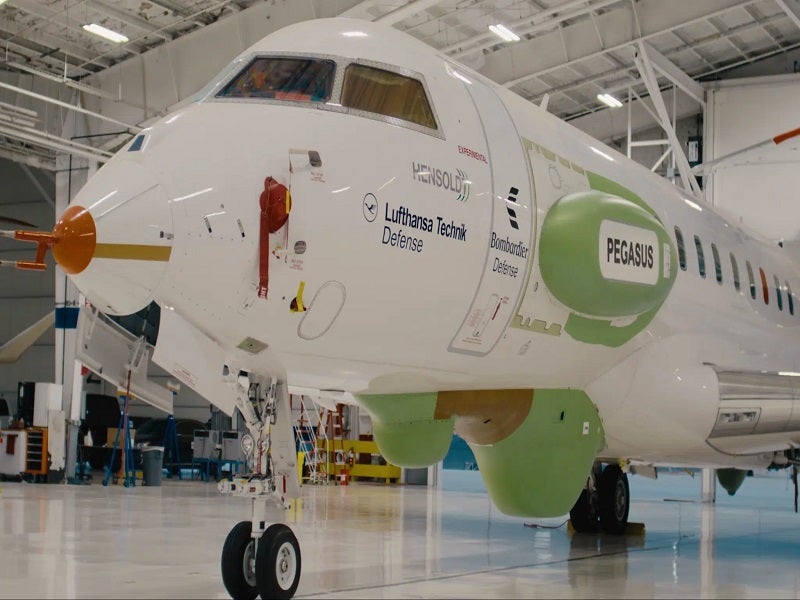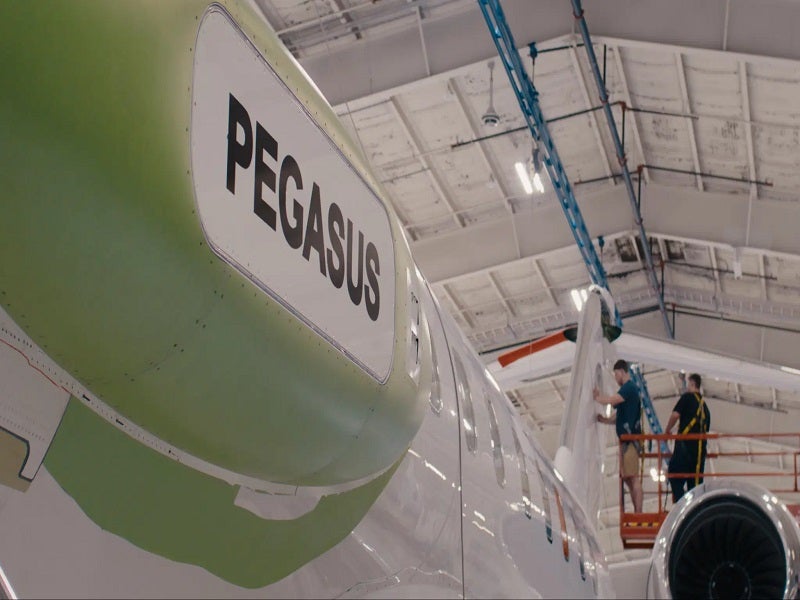The Pegasus Signals Intelligence (SIGINT) aircraft is designed to gather information about enemy units and their command structures for the German Air Force.
Sensor solutions provider Hensoldt secured a contract valued at more than €1bn ($1.074bn) to deliver the Pegasus system in June 2021.
Lufthansa Technik Defense, an aircraft maintenance, repair, overhaul and modification services provider, and Bombardier Defense, a specialised aircraft platforms provider, are collaborating with Hensoldt on the Pegasus programme.
In June 2024, significant progress on the Pegasus SIGINT aircraft development was announced, marking the rollout of the first aircraft with structural modifications from Bombardier Defense’s facility in Wichita, Kansas, US.
The first aircraft is now being prepared for ground and flight testing. It will undergo further integration work at Lufthansa Technik Defense’s facilities in Hamburg, Germany, following successful testing.
Several small and medium-sized enterprises based in Germany, Canada and the US are engaged in the project, forming an integral part of the supply chain for all participating companies.
Pegasus SIGINT aircraft design and features
The Bombardier Global 6000 aircraft has an exterior length of 99.5in, a height of 25.6in and a wingspan of 94ft. The cabin height, length and width are 6.2in, 43.3in and 7.11in respectively.
The aircraft has a takeoff distance of 6,476ft and a landing distance of 2,236ft. It has a maximum operating altitude of 51,000ft and an initial cruise altitude of 41,000ft.
The aircraft can travel at a top speed of 0.89 Mach, with a high-speed cruise of 0.88 Mach and a typical cruise speed of 0.85 Mach. It has a maximum payload capacity of 5,770lb and a maximum range of 6,000nm.
The maximum takeoff weight of the aircraft is 99,500lb, and the maximum landing weight is 78,600lb. The maximum ramp weight is 99,750lb and the maximum zero-fuel weight is 58,000lb.
Pegasus Signals Intelligence (SIGINT) aircraft development
Hensoldt is leading the integration of the Pegasus SIGINT system into three Bombardier Global 6000 aircraft with its Kalaetron Integral reconnaissance solution, which enables the collection and analysis of electronic signals from military radar and radio systems.
Lufthansa Technik Defense is serving as a subcontractor responsible for acquiring, modifying, and integrating the reconnaissance system onto the platform.
Bombardier Defense initiated significant structural alterations to the aircraft to accommodate the Kalaetron Integral system in November 2022.
In November 2023, the critical design review for the Pegasus SIGINT system was approved by the Federal Office of Bundeswehr Equipment, Information Technology and In-Service Support. The approval enabled the Pegasus system to enter the implementation phase.
Hensoldt’s overall mission system design was accepted at the end of 2023.
Bombardier is currently undertaking modifications on the remaining two aircraft at the Wichita facility.
Kalaetron Integral reconnaissance solution details
The Kalaetron Integral reconnaissance solution seamlessly combines intelligence from both radar signals and communication signals.
It can process and analyse all the information collected through its big data management software. Machine learning and AI algorithms power the system’s automated workflows, speeding up decision-making and lessening the operators’ workload.
Kalaetron Integral offers continuous frequency coverage from less than 30MHz to 40GHz. It can automatically generate and constantly update the electronic order of battle and is designed for multi-platform and multi-domain operations.
Flight deck and avionics details
The aircraft features the Bombardier Vision flight deck, four large displays, a head-up display, an enhanced vision system and synthetic vision system, graphic flight planning and multiscan weather radar.
It also features the latest performance-based navigation systems such as satellite-based augmentation systems, a wide area augmentation system, localiser performance with vertical guidance approach and area navigation.
The aircraft utilises en-route required navigation performance (RNP), RNP authorisation-required approaches, controller pilot data link communications and high-speed satellite communication.
Propulsion
The Bombardier Global 6000 aircraft is powered by Rolls-Royce BR710A2-20 turbofans, delivering a thrust of 65.6kN and flat rated to ISA +20°C, ensuring optimal performance during operations.






